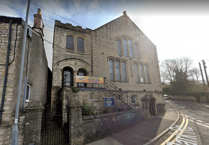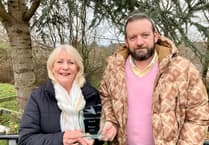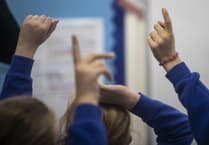It is with great sorrow that the Trustees, Volunteers and Manager of Radstock Museum announce the passing of their Chairman, Dr Nicolas Hall. Nick, as he preferred to be called, died peacefully at home on Tuesday, 15th June after a short illness and the truly heartfelt thoughts of everyone involved with the Museum are with Nick’s wife, Kitty – also a dedicated Museum volunteer, and his family.
Nick volunteered at Radstock Museum as a steward before becoming a Trustee in 2012 and Chairman in 2014. He was a very popular Chairman with all the volunteers; he was always good humoured, a great listener, a keen supporter of new ideas and a superb leader.
When he took over as Chair, the world outside the was changing, with many of the original Museum founders and former coal miners moving on or passing away. New technologies and ideas were helping to keep other local and national museums relevant.
Nick realised the Museum needed a refresh and a rebrand so that it would remain attractive to returning and traditional visitors, whilst becoming a destination for a wider, all-inclusive and ever-changing audience.
The new name of “Somerset Coalfield Life at Radstock Museum” was aimed at giving the public a better understanding of what they might encounter on visiting – which is the story of the everyday life of all those who lived and worked in the Somerset Coalfield in its heyday.
With the new name in place, Nick worked hard with the Museum team, including employing a dedicated, temporary Development Coordinator, to improve the displays by making them more interactive and ‘hands on’.
On one occasion this led him to giving a temporary home to Trigger the horse (a fibreglass horse on a long-term loan to the Museum from Oasis Carnival Club). The horse needed repairs, a repaint and a new mane and tail. And so it lived for many months in Nick’s garage while the work was carried out! Trigger now stands centre stage in the Museum.
Nick embraced working with partners in the community and one very successful project was with Bath (formerly Radstock Technical) College where he supported students with developing the ‘Virtual Reality Coal Mine Experience’ that has become a very popular attraction for children, teenagers and adults alike. He also worked with local solicitors, Thatcher + Hallam on various projects that would attract more visitors.
Working with the Alzheimer’s Society, Nick instigated dementia training which encouraged many volunteers to become ‘Dementia Friends’. Just before the pandemic, he was working on projects with John Turner, CEO of Visit Somerset, for the Museum to be a welcoming destination for the LGBTQ+ community and to bring tourists from Bath to the Museum as part of regular day trips to Wells.
Perhaps one of the most challenging projects Nick supported was to turn the entire upstairs of the Museum into a theatre for a week, complete with set, lighting and sound rig plus audience seating, with the downstairs converted into a backstage changing room and the theatre foyer and bar; this was so that a local youth theatre company could stage a sell-out play for the community to commemorate the centenary of the end of WWI in November 2018. The powerful production was a great success for the Museum. Nick, with his ‘can-do, nothing is impossible’ attitude, managed to persuade the Trustees to wholeheartedly support closing the Museum for a week to stage the event, a gamble that paid off.
In 2019, Nick’s plans to hold community cafés for local people came to fruition. During the mornings when the Museum was closed to the public, the tearoom provided a venue for cafés for people with memory loss and their carers, for local history cafés, and for a café for veterans in conjunction with the Royal British Legion. These proved to be a great success and it is hoped that they will resume either later this year or early next year.
Jill Webb, Head of Education at the Museum, said: “Nick gave the Education Team a great deal of support – he was always ready to listen and act as a sounding board to some quite wacky ideas. With some discussion and a few tweaks, we were always able to achieve what we set out to do and most importantly, nothing was ever dismissed as being impossible. He will be remembered for his kindness and unfailing good humour.”
Linda Hughes, Head of Catering and an Education Team volunteer added: “The Museum’s children’s activities, especially the Victorian and Edwardian Christmas events, became a ‘must attend’ outing for many families; the fact that this was achievable was very much down to Nick’s support. At these events he would be master of ceremonies, directing families to activities dressed as a Victorian school master or in his stripy blazer and straw boater at the Victorian seaside events, always with a smile on his face and a twinkle in his eye.”
Nick was also passionate about the more serious, informative side of the
Museum and worked with the exhibition team for many years producing well researched and presented exhibitions with artefacts. He was instrumental in modernising the upstairs exhibition area in which one of his mini-exhibitions on the Spanish flu pandemic is currently on display. Exhibition posters he completed earlier this year, commemorating the 1921 coal strike and other key events, will be on display from July until the end of November.
Nick greatly respected the former colliery workers and miners whose story the Museum tells. Every year Nick and his wife Kitty helped run the annual Miners’ Reunion. Julie Dexter, Editor of the Museum’s history journal and organiser of the reunion said: “My lasting memory of Nick will be at the Miners’ Reunions. I will never forget him quietly behind the scenes in the kitchen, washing or drying up, making pots of tea, pouring glasses of ale, or wiping down the tables. He will be missed terribly.”
Jos Binns, Museum Treasurer, added: “Nick was a man of many shirts, mostly of a tropical variety, which were best viewed through sunglasses! He was able to extract money for the Museum from a large number of grant-giving bodies by a mixture of charm and determination. He had an encyclopaedic knowledge of railways and could probably tell you the name of every engine which had ever travelled past the Museum, and who was driving it. Right up until just before he died, he was working on converting model rolling stock for use on the Museum’s railway layout. I will miss him, both professionally and also as a good friend.”
Head of Science in Radstock and former Museum Chairman, Clem Maidment, said: “In 2013, Nick did sterling and vital work in the production of Documentation, including a Forward Plan, for accrediting the Museum with the Arts Council. I recall he gave two interesting talks for Science in Radstock, the first on Rheumatoid Arthritis in April 2012 and another on Drug Developments in November 2016. The news is a tragic event for his family, we deeply feel for them and a sad loss for the Museum. “
Lucy Tudor, Head of Museum Publicity said: “The last time I saw Nick was
earlier this year when the Radstock heritage boards, which we worked on together, were put into place in the town. It was a beautiful, sunny day and Nick was raring to get back to museum business as soon as lockdown was over. We chatted and laughed and I am so glad he was able to see our work complete and in situ. I will miss him terribly.”
Every one of the Museum volunteers has fond thoughts and memories of Nick, too many to add in here, but essentially the message from all your Museum colleagues, Nick, is this: “Thank you for the fun and laughter, the kind empathy and support, the passion and enthusiasm, the new and innovative ideas and for being the father of the Museum family and a true gentleman. We will miss you so much.”
The Museum plans to have some form of lasting memorial to Dr Nicolas Hall within the Museum and will shortly begin to consider what that might be. Lucy Tudor



